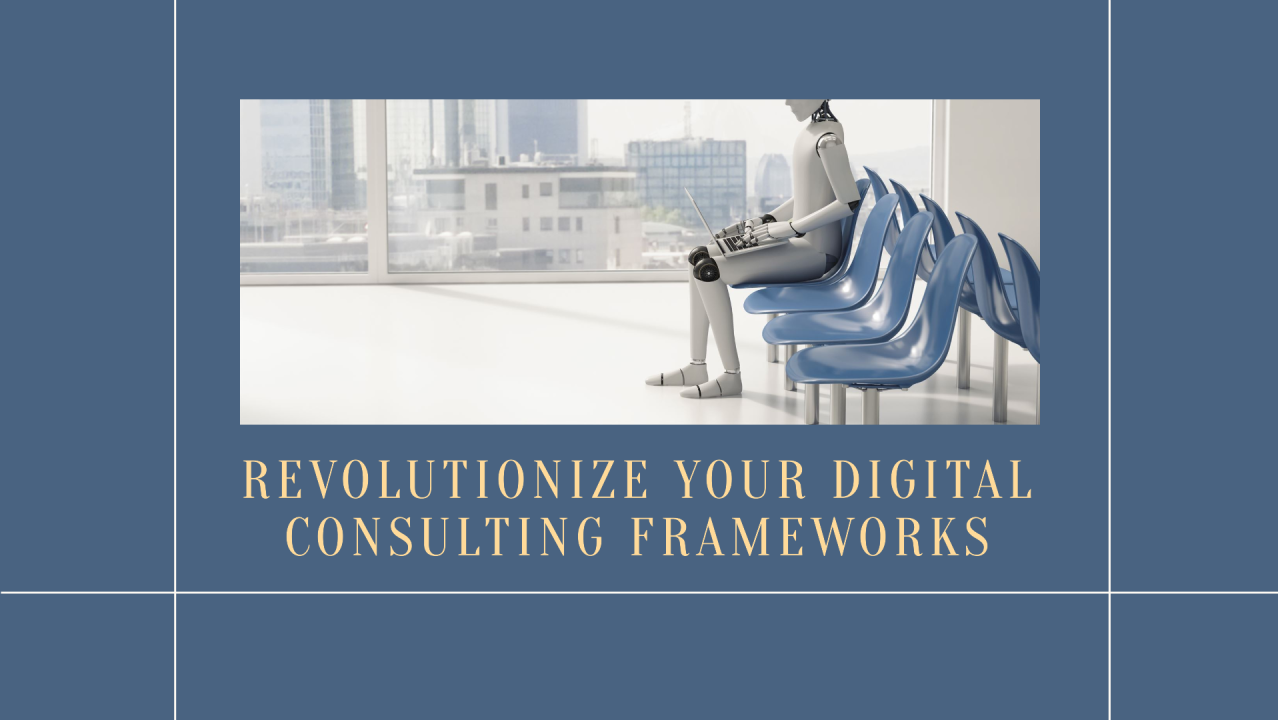Article by Alumni Services' Steven Yates: Do we need to re-imagine our Digital Consulting Frameworks?
Source: Written by Steven Yates, Director and CTO of Alumni Services
The consulting world needs a new approach.
Since Dr Harold Leavitt produced the Diamond model six decades ago, the mantra of consultancy and business transformation has been People, Process, and Technology. This holy trinity, golden triangle, or three-legged stool was questioned by Forbes, in 2022, and found to be ‘striking the right balance and negotiating trade-offs to design effective solutions that meet long-term business goals.”
If Forbes says it, who are we to argue?
Yet as we reach the quarter-way mark through the 21st century, we can observe the rapid evolution of business and the rise of job roles that could not have been dreamed of only a few years ago. Consider that a Cryptocurrency Asset Advisor or Telemedicine Veterinarian did not exist only five years past. We must, therefore, acknowledge that there is a significant shift in business needs that the de facto model may not fully address.
Today we are part of an unprecedented intergenerational workplace, ranging from Baby Boomers to Generation Alpha, with the eldest of the latter only fifteen years old today, but accounting for the largest generation the planet has ever seen. These Generation Alpha’s are already influencing global technology and human engagements more than the retiring Baby Boomers can ever understand. Many Gen Alpha’s are amassing millions of followers on social media, shaping consumer behaviour and retail industries from skincare to coffee faster than the brands even know how to react or adjust their products.
We have five vastly different generational mindsets handing over, leading, doing, shaping and changing what good looks like in the Boomers, Gen Xers, Millennials, Gen Zs and now Gen As.
The explosion of data being generated is immense with 328 million terabytes of data created each day. 90% of the world's data has been created in the last two years and that data is all being made available to learning machines as the Artificial Intelligence phenomenon marches ever closer to the point where artificial intelligence surpasses human intelligence or the moment where AI is no longer under human control. This point in time is known as the Singularity. With all these colliding forces, perhaps it is worth reviewing the future of the first-class citizens of our trinity, and while I agree that the framework is very valid, perhaps it is time for an overhaul?
Giving Forbes some credit – let's reconsider the validity of each of the People, Process, and Technology dimensions.
People: The most complex organisms on the planet and arguably the single biggest source of success or failure in any transformation. The best technology, the best processes, and the best intention are nothing if people do not buy in, adapt and utilise the changes needed to technology and process.
The future though, is not only about people. Artificial Intelligence entities are increasingly taking on roles such as board members, advisors, and customer service representatives. In fact, we already have a whole AI workforce. The future organisational design and, indeed, the entire business architecture needs to be re-imagined including all participants (human or not) or risk being obsolete.
Cognition Labs already employs an AI software engineer named Devin who can plan and execute complex engineering tasks requiring thousands of decisions. Devin can recall relevant context at every step, learn over time, and fix mistakes. Similarly, 11X and Artisan benefit from Alica and Ava, AI business development resources that can discover leads using over 250 million contacts & 65 data points. Artisan has also introduced Liam the marketer and James the customer services rep to their team.
Even in healthcare, AI's role is expanding, as seen with Hippocratic.ai's AI-powered healthcare agents. Aiden Insight, an AI observer, recently joined the board of the Abu Dhabi-based International Holding Group (IHG) as a non-voting member. This follows earlier precedents like that set by Deep Knowledge Ventures, a Hong Kong-based venture capital firm, which added an AI named Vital to its board with observer status back in 2017.
Contrary to much of the current rhetoric, the AI impact on the job market should be celebrated, not feared.
We are likely to experience a form of Jevon’s paradox, where the short-term reduction of jobs will be counterbalanced by the long-term creation of many new jobs and job types, AI will render a much higher demand for human integration and thus higher employment.
Process: Process and more specifically, process re-engineering, has been – in varying shapes and forms - the darling of simplification, standardisation, optimisation and cost reduction of the business world since the principles of management theory by Frederick Winslow Taylor in 1909, and then re-advocated by Michael Hammer in the 1990s.
In our current age of hyper-personalisation and dramatic expectation discrepancies across our five generations, we are seeing more organisations employing knowledge workers who have the ability to, rather than follow a scripted process, work within some prescribed boundaries and provide a service which is appropriate to the specific time, location and individual or system with whom or which they are interacting.
We are watching interactions being shaped in real time by the data informing those interactions. We are enabling many of those interactions to be completed by robots in natural language, acting within a set of boundaries and guided by the desires of the enquirer rather than by following a set pre-defined decision tree. There is a rise in tooling which interrogates the vast data troves, assigning and using active metadata to inform and advise us on how we should be changing our processes (sometimes dynamically) to suit changing situations.
A notable example of this is asset maintenance, maybe aircraft, vessels or heavy machinery. Today there is a specific maintenance process which is followed routinely. If we consider aircraft maintenance or maintenance, repair and overhaul (MRO). There are typically four check processes A, B, C, and D. A and B checks come under Line maintenance or Light Checks, while C and D checks are categorized under Base or Heavy maintenance. During an A check the process is:
- Inspect the aircraft exterior for signs of damage or wear and tear.
- Check aircraft fluid levels (oil, fuel, etc.)
- Inspect tires and brakes for any sign of wear and tear.
- Check the avionics system (radios, transponders, navigation systems)
- Check the aircraft flight controllers (flaps, ailerons)
In a new world, IoT data combines to provide much more accurate real-time information which has the potential to change and customise the process the engineer takes each iteration. For example, an oil sensor shows low oil. The system checks the maintenance records and determines that the oil level drop is consistent with normal use and the process followed is to merely top up the oil. In another example, the system determines that the oil drop was uncharacteristically quick that the oil viscosity has increased (indicating high dirt content) and that the right engine is running one degree hotter on average since the previous oil change. The suggested process (by the system) could now be:
- Check the brand of oil and ensure there has not been a change that needs to be reversed.
- Check the engine (the system will probably do some of this and kick off another custom process, but let’s ignore that for now)
- Flush the oil system to remove increased dirt residue.
- Top up the oil.
Of course, this is an illustrative simplification of the processes, but you can see that in these scenarios, there is actually no defined process, but rather some guard rails (the oil level, viscosity and engine temperature) that if breached suggest a varying set of actions. In essence, customising the process for each and every interaction or check iteration.
Technology: The Information Age has yielded more invention and change to human society than any age before it. Globally, applications for patents have increased from 1 million in 1995 to 2 million in 2010 and then 3 million in 20164. The use of technology has proliferated throughout every industry and society to the extent that the Gen Z generation is often referred to as the digital natives, having grown up in a world where they have never known a time without the internet, smartphones, social media, and virtual worlds.
Technology's role in our future society echoes the ubiquitous nature of the pen in the latter half of the 20th century. Just as writing instruments evolved to meet individual preferences — be it a fountain pen, ballpoint, or quill— technology and automation are becoming increasingly democratized and individuals/organisations can select them to best fit their specific needs and desires, beyond competitive advantages.
As we edge closer to the point of Singularity, which Popular Mechanics predicts at 2031, we are entering an era where the pace of change will make previous technological advancements of the information age seem paltry. We are moving into a new age, potentially the age of the Singularity.
We already see AI and Robots cutting out code or creating technology to fit defined purposes, so how far is a future where you go into a store (probably in the metaverse) and explain what you need and are delivered a piece of technology or a system to meet that need – much like buying a collection of coloured crayons to draw a picture.
This is not to be feared. Do not make the mistake of falling into the fear culture being generated by the apocalyptic narrative surrounding AI, for this has about the same odds of occurrence as the digital renaissance narrative where AI eradicates poverty, homelessness, crime and hunger, enabling humanity to focus on creativity and pleasure.
The apocalyptic narrative just sells more movies.
What becomes important in this Singularity Age is governance.
I am not referring to the many archaic laws and regulations that were established in the industrial age with some attempts to keep them relevant through the information age. We need to start with the future in mind, not the constraints of the past.
We need not be constrained by fear nor be naive to human malice and greed and craft governance structures which form the boundaries of protection within our organisations, our nations, and even our homes, to allow the freedom to explore the realm of possibility and change the world as we know it without endangering ourselves or others.
The critical question still remains: what next? How do we overhaul our existing frameworks to remain relevant and effective?
Defining the New Trinity
I have seen attempts, in some cases very good attempts, to refit this existing model with the new age requirements - often with data at the centre of the proverbial Venn diagram.
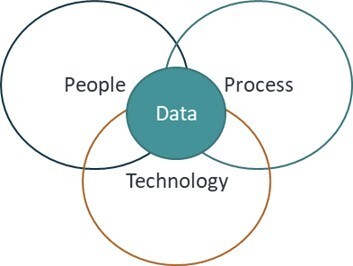
While I commend them for their efforts, they are holding onto a legacy framework. I propose a new Gen A trinity should emerge to direct our business transformation and future needs – replace People with Actors, Process with Data, and apply Governance instead of technology.
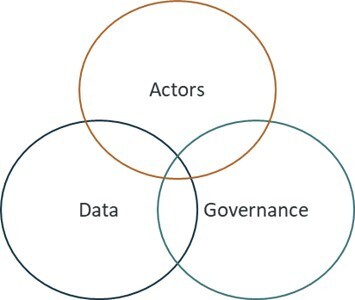
Actors: The Oxford definition describes an actor as “a participant in an action or a process”. The key to the change from the legacy “People” is that actors in this framework are all actors, both human and non-human and may include people, humanoid robots like Sophia (the most advanced humanoid robot today), non-humanoid robots like R2D2 (of Star Wars fame), physically manifested Artificial Intelligence such as Altron (from the marvel universe) or non-physically manifested Artificial Intelligence such as J.A.R.V.I.S from Iron Man. The biggest opportunities for the AI workforce today are where human unit economics are high. There are a few key characteristics that should be considered when we review the ACTORS pillar of the new trilogy:
- Substantial amounts of simple, repetitive, high-volume tasks.
- The skills required are particularly expensive in Human actors.
- Poor labour market due to skills shortage, unrest, high turnover or geographic location.
- Highly specialised skillsets requiring long lead times to productivity.
- Roles with large volumes of data processing to be effective.
- Roles with critical service levels (low fault tolerance), where human error can lead to damage of critical infrastructure or death.
- Highly fragmented roles definitions requiring multiple systems and duplicate data entry.
Data: Originally, I started with “Actions” as the second pillar of the new trinity of actions (specifically, next best actions) which felt like the logical replacement for process – and it provided a really nice acronym AAG.
The more I considered “Action” the more it became evident that actions were, in fact, the outcome.
The key aspect on which businesses (and consultants) should focus was not then to determine what those actions should be, much like how we would historically have determined the best and most efficient processes, but rather the system to derive those actions, from the almost infinite and possibly unknown potential actions that could be executed in each unique situation. The derivation of these actions ultimately begins with understanding each unique situation, and that leads to data.
A common misconception is that data is merely a product of technology. In reality, Data is by definition a collection of facts and statistics collected together for reference and/or analysis and is completely independent of technology, while technology plays a critical role in creating, processing, manipulating, transmitting, transforming and analysing data. The relationship between Data and Technology is analogous to how a pen relates to a novel: one facilitates the creation of the other but does not define it.
Data serves as the foundational element of cognition in business processes:
- Creation of Information: Adding context to data is the change required to convert raw data into information. This information is essential for us to draw conclusions.
- Development of Knowledge: Time is the addition to progress Information to Knowledge. Knowledge is often encapsulated in models, axioms, theories, concepts or definitions. It is from Knowledge which we derive meaning, transforming it into a valuable asset for strategic decision-making.
- Wisdom: Wisdom emerges when we apply insight, which comes from the long-term usage of knowledge in various scenarios to understand the different applications and consequences.
- The use of this Wisdom provides purpose, and purpose ultimately replaces process, but is at its core, underpinned by data.
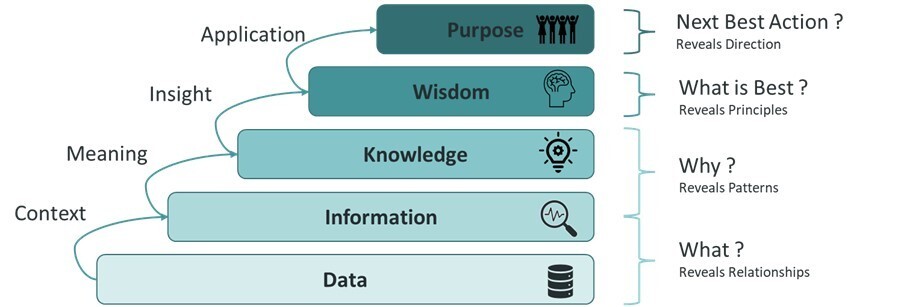
A few early considerations when assessing the data pillar of the trinity are:
- Degree of personalisation and hyper-personalisation required to drive customer value and increase loyalty.
- The diversity of the customer base (ethnicity, sexual orientation, language, religion, geographic location, etc.) and the challenges that provides to service.
- Speed of service delivery
- Degree of complex emotions required to execute an action (empathy, sarcasm, regret, delight, etc.).
- Transaction margin of core value products or services
Governance: Without the definitive and auditable flow of a process, and with the new freedom of both human and non-human actors to make a choice of any number of actions in any given situation, it becomes critical that guard rails or boundaries are put in place such that the choice of actions is limited to those actions that cannot cause harm physically, digitally, commercially, environmentally, or politically.
There also needs to be a mechanism of justification such that any actor can justify why the action taken was in fact the next best action, how it was derived and that it falls within the set guard rails. Without this governance mechanism, this new framework collapses as it creates an environment primed for anarchy.
There are many considerations that need to be addressed when defining a future governance model, but we need to be wary of applying the governance of today to the business models of the future, as while governance is critical, it also has the potential to scuttle the whole endeavour of re-imagining the future business. Many of the structures of today, such as Data Protection Acts, ISO Standards, IFRS Reporting, the Patriot Act, and many more, may not be fit for purpose for the future. This requires us to create a governance system flexible enough to manage the current regulations, while enabling the future business model. This may put an additional burden on businesses to work with regulators, governments and standards bodies, but will enable us to move into the future at a less sedate pace than we see today.
Some considerations to take into account:
- The rule of law
- Governmental or regional regulations
- Industry-specific regulations
- Corporate regulations
- Sanctions (international and local)
- Audit requirements.
- Certification requirements
- Company values
- Generational values
Practical Applications of the New Framework
To illustrate the practical implications of this new trinity, consider these simplified use cases:
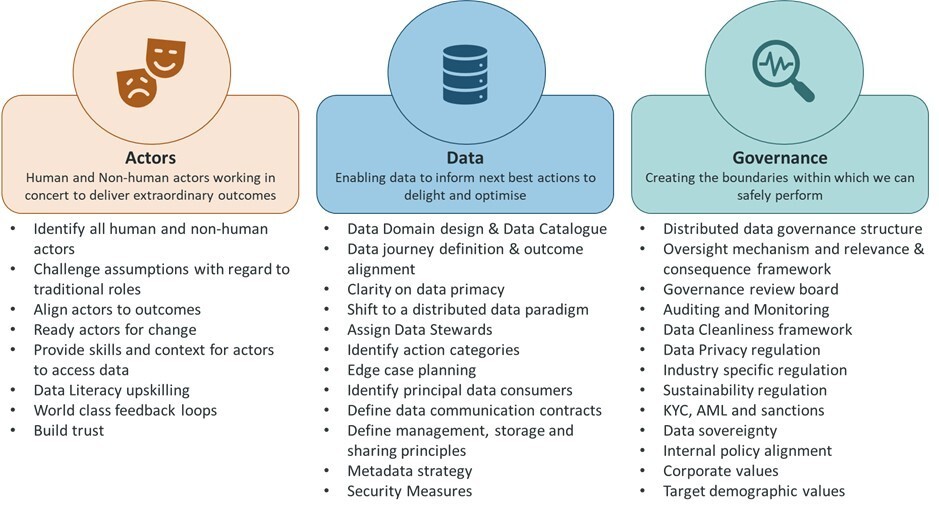
USE CASE #1: High Turnover Rate in a Department
Actors: Are people being asked to perform menial and repetitive tasks? Are employees scared of making decisions? Do staff feel they have access to the correct information to do their jobs effectively? Do staff feel their jobs are threatened by digitisation and AI?
Data: Are we using the correct data points to inform our hiring decisions? Do we customise the onboarding journey to each individual role, experience, strengths and weaknesses? Do employees know where to go to get accurate information? Do we have feedback mechanisms to provide early detection of dissatisfaction or performance drift? Do we understand our employees’ values and how they align with the organisational values?
Governance: Are we protecting our employees? Are we protecting our employee’s data? Are we providing clear guidelines within which we empower employees to make decisions? Do we have good visibility on decision-making and a framework to evaluate efficacy and feedback? Are our policies aligned with the expectations of the generation demographic of our people?
USE CASE #2: Difficulty in Managing Inventory Levels (very simplified for illustration purposes)
Actors: Are humans expected to collect and input large volumes of information? Do staff trust the feedback from the automated systems, do we have very manual end-of-day / end-of-month inventory processes?
Data: Is the Inventory Data domain accurately understood? Is the Owner of the Inventory data domain an inventory or product specialist? Are we clear on where data primacy resides? How is this data being updated and by whom? Are there time-related issues relating to data realisation (e.g. time zones)? Is data being transferred accurately between actors and systems? Are we tagging and indexing our data and inventory accurately?
Governance: Does our inventory data have any Personal Identifiable Information that requires specific protection? Do we have any industry obligation to report inventory? Is our inventory accurately reflecting our sustainability or carbon offset position? Do we have the correct structures and cadence in place to ensure accuracy? Is our monitoring real-time and accurate? Is the inventory Audit trail immutable and complete?
Call to Action
As we advance further into the digital era, it's clear that traditional models must evolve.
I put it to the #DigitalTransformation community to consider the proposed framework and not rely on the legacy ‘first-class citizens’ and blueprints from the industrial age which fall behind on inclusivity and flexibility.
By transitioning to a framework of Actors, Data and Governance, we can better leverage technological advancements and create more resilient, adaptive organizations – the digital future we not only envision but deserve.

